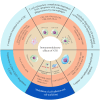Optimizing anti-thymocyte globulin dosing in allogeneic hematopoietic stem cell transplantation: individualized approaches and clinical implications
- PMID: 40861446
- PMCID: PMC12370499
- DOI: 10.3389/fimmu.2025.1634157
Optimizing anti-thymocyte globulin dosing in allogeneic hematopoietic stem cell transplantation: individualized approaches and clinical implications
Abstract
Allogeneic hematopoietic stem cell transplantation (allo-HSCT) is a potentially curative therapy for hematologic malignancies. However, the initial clinical experience with allo-HSCT revealed a concerning prevalence of severe graft-versus-host disease (GVHD) and graft failure. Subsequent randomized studies highlighted the role of anti-thymocyte globulin (ATG) in reducing acute and chronic GVHD and graft failure, although it did not improve overall survival. Pharmacodynamic studies have established an association between ATG concentration and the incidence of GVHD and life-threatening infections. However, ATG concentration at designated timepoints showed no such correlations with non-relapse mortality and overall survival in allo-HSCT. There is a delicate balance between ATG exposure and the outcomes of allo-HSCT. More specifically, insufficient ATG exposure may diminish its function on GVHD prophylaxis, while excessive ATG may delay immune reconstitution and increase risk of disease relapse and infection. Considering the significant inter-individual heterogeneity in ATG pharmacokinetics, individualized ATG dosing could potentially increase the proportion of transplant recipients attaining the optimal ATG exposure. Recent studies have shown that individualized ATG dosing, guided by absolute lymphocyte count or therapeutic drug monitoring, can improve optimal exposure attainment rate. Which indicated a potential approach to achieve superior transplant outcomes. This review summarizes the advances and the challenges of individualized ATG dosing in allo-HSCT.
Keywords: antithymocyte globulin; graft-versus-host disease; hematopoietic stem cell transplantation; pharmacokinetics; precision dosing; therapeutic drug monitoring.
Copyright © 2025 Wang, Yang, Du, Dou and Liu.
Conflict of interest statement
The authors declare that the research was conducted in the absence of any commercial or financial relationships that could be construed as a potential conflict of interest.
Figures



Similar articles
-
Adjustment of low-dose ATG exposure improves outcomes in allogeneic hematopoietic stem cell transplantation: a prospective multicenter study.Cytotherapy. 2025 Aug;27(8):962-972. doi: 10.1016/j.jcyt.2025.05.009. Epub 2025 May 23. Cytotherapy. 2025. PMID: 40526052
-
Polyclonal anti-thymocyte globulins for the prophylaxis of graft-versus-host disease after allogeneic stem cell or bone marrow transplantation in adults.Cochrane Database Syst Rev. 2012 Sep 12;(9):CD009159. doi: 10.1002/14651858.CD009159.pub2. Cochrane Database Syst Rev. 2012. Update in: Cochrane Database Syst Rev. 2023 Jun 21;6:CD009159. doi: 10.1002/14651858.CD009159.pub3. PMID: 22972135 Updated.
-
First-line allogeneic hematopoietic stem cell transplantation of HLA-matched sibling donors compared with first-line ciclosporin and/or antithymocyte or antilymphocyte globulin for acquired severe aplastic anemia.Cochrane Database Syst Rev. 2013 Jul 23;2013(7):CD006407. doi: 10.1002/14651858.CD006407.pub2. Cochrane Database Syst Rev. 2013. PMID: 23881658 Free PMC article.
-
Model-Based Antithymocyte Globulin in αβhaplo-Hematopoietic Stem Cell Transplantation Facilitates Engraftment, Expedites T Cell Recovery, and Mitigates the Risk of Acute Graft-versus-Host Disease.Transplant Cell Ther. 2024 Aug;30(8):810.e1-810.e16. doi: 10.1016/j.jtct.2024.05.015. Epub 2024 May 18. Transplant Cell Ther. 2024. PMID: 38768907 Free PMC article.
-
Polyclonal anti-thymocyte globulins for the prophylaxis of graft-versus-host disease after allogeneic stem cell or bone marrow transplantation in adults.Cochrane Database Syst Rev. 2023 Jun 21;6(6):CD009159. doi: 10.1002/14651858.CD009159.pub3. Cochrane Database Syst Rev. 2023. PMID: 37341189 Free PMC article.
References
-
- Bacigalupo A, Lamparelli T, Barisione G, Bruzzi P, Guidi S, Alessandrino PE, et al. Thymoglobulin prevents chronic graft-versus-host disease, chronic lung dysfunction, and late transplant-related mortality: long-term follow-up of a randomized trial in patients undergoing unrelated donor transplantation. Biol Blood Marrow Transplant. (2006) 12:560–5. doi: 10.1016/j.bbmt.2005.12.034, PMID: - DOI - PubMed
Publication types
MeSH terms
Substances
LinkOut - more resources
Full Text Sources

